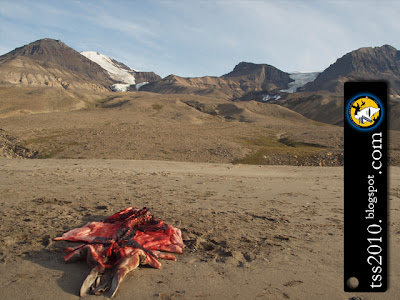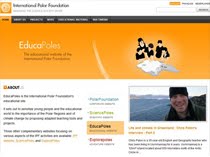In the beginning of the blog, and probably in the midst of many subsequent posts, I have written about all the factors that made for a bad start to the expedition. I never wrote about how I was ready to give it up a few weeks before starting.
A very dear friend, my "second mother", passed away about a week and a half before I was set to dip my paddle in the water. She had fought for more than a year against a failing body and could sadly fight no more. Her passing had a huge impact upon me and my family, incredibly so for my mother, and on the brink of setting off on my own adventures, I realised that I might be needed elsewhere. The uncertainty of my own adventures and the risks involved did not encourage a parent struggling through the loss of a dear friend. I started to check out flights to Britain.
However, the sense of adventure and "sucking the marrow out of life" was instilled in me from an early age and I have my mother and "H" to thank for that. Between them they gave their children such encouragement and ambition that we three suddenly found ourselves living as far abroad as New Zealand, USA and Greenland, and the parents, all four of them, started to wonder what they had done wrong. The answer was "nothing", unless of course they had hoped we would live around the corner and work in our home town for the rest of our lives.
My mum and I agreed that I would continue, I would just be careful, and careful I was. I just don't think I can take all the credit. There's this little thing, a nagging, wonderful feeling, that I wasn't alone. The raven was with me.

Ravens are Arctic birds, I realised that as soon as I landed in Uummannaq. They have a huge vocal range that penetrates the Arctic night and frolics under the midnight sun. I once chose my Native American totems with the help of a friend and a pack of totem cards one night in Indiana, USA. Whether we did it right or not is not so important for me, I just remember it being a powerful experience. Having chosen eight totems I had one remaining. I remember thinking that I really wanted the wolf, the teacher, he who only comes if requested. It was a tense moment. There were two cards on the hardwood floor before me. I wanted the wolf, but I remember thinking that I would be honoured if the raven chose to come instead. I turned the card over and was elated to see the wolf staring back at me. The other card, yes, it was the raven.

I wrote them down on a piece of yellow legal paper that night, they have been folded up alongside my driver's licence ever since. Whereas the teachings of the wolf have supported me in my career and personal life, the raven was waiting. But he is a trickster, I have seen the raven steal food from my sledge dogs, fish from my drying rack, and never has he been so cheeky as when he has flown off at the last minute when I have tried to take a photo of him. Or perhaps her? After four years with no success, returning to camp after my last trip into Qaarsut on the 19th of July, a raven stopped me in my tracks. It was, I like to imagine, the same raven that had watched me pitch camp that night I arrived in Qaarsut. With my camera in hand I wondered how close I could come. The answer was very close indeed. The raven simply eyed me as I took photograph after photograph within but a few metres of this tough old Arctic hand.
I don't remember how long I spent with the raven, but after four years of trying, I finally had some great photos of this incredible bird. I wondered then; I wondered if there was some element of "someone watching over me" and that this someone had come in the shape of a raven? Spiritual nonsense or a comforting yet completely natural coincidence? I don't know. This world is bigger than me, and tulugaq, the raven, was another mystery. Tulugaq's arrival though was timely, I was forced to wait in camp for several hours as the fog of the morning stayed long through the day. Patience is just as important as having a guardian angel in the Arctic. It was my patience that prevented me from paddling the last few kilometres home, though I was eager, and yet, it was the raven that kept me in camp when I wanted to be on the water.

Of course, on this, the last day of my journey, my patience was beginning to wear thin. As the raven departed, I too chose to get ready, fog be damned, the only way out is through! My attitude to fog had already changed at this point. From the nerve-racking hours I spent negotiating the fogged-in coastline near Ukkusissat, I had grown and learned to deal with this otherwise unpleasant element. My only concern was the size of the monster bergs hidden in the fog that so often ply the waters in and around Uummannaq. I would paddle as far as I could see and so I took off along the coastline with the intention of stopping should the visibility deteriorate further.

Patience, or lack of it, got the better of me though. I wanted to finish this journey and the thought of eating my first proper meal with Jane that night was too much of a temptation. I turned a sharp left and paddled into the fog. Without a GPS - I am not a fan - I took a compass bearing and pointed my bow in the direction of where Uummannaq island should be and decided to hope for the best.
Predictably, the visibility deteriorated. Typical, my last day on the water and I was running one of the greater risks of the expedition. This thought was confirmed when I heard several loud reports in the fog around me. Too sharp and short to be an iceberg calving, I realised that hunters were out shooting for seals. Marvellous! My raven was nowhere to be seen,
I was nowhere to be seen. It could soon be open season on English kayakers!
As the fog lifted in between though, the beauty inside the bubble became apparent. As the light from above the fog bank lit the tops of the icebergs, the light was transfused down through the ice. It was magical. Using smaller bergs as way-points I paddled from berg to berg, past the occasional shot from a .22, long past the point of no return. I was halfway across the fjord, about 6-8 kilometres from Uummannaq, if I was pointing in the right direction. Compass needles tend to be a little screwy in the north.
And then, the fog lifted, just for an instant, and my island reared up out of the water. I was on course for Spraglebugten. Life was good. I was making reasonable time and would perhaps even arrive in time for the evening meal at the hotel.
The closer I got to Uummannaq, the more often I heard the growls and barks of sledge dogs anchored on the island. I had met many dogs on my journey, but these mutts were local and a very welcome sound indeed. I was, however, too focused on journey's end to reflect more on my experiences. Like the mantra I have written on the back of Jane's PFD: "just keep paddlin'", I was in the zone and determined to make landfall. It was only a question of time too, the sea was calm and I was beyond the fog bank.
Rounding the "corner" of Uummannaq and on entering the harbour, a hunter and his family cruised past in their boat. In Greenlandic he asked if it was me that had paddled around the settlements? I replied that it was. "Ajunngilaq!" he said. My sentiments entirely, I thought. Smiling broadly, I paddled into the slipway just to the right of the hospital, in front of the qajaq club.
Mario, the uncle of the boy who shot his first seal the day I left, way back in June, was fixing a boat on the shore as I came in. We chatted a little and I felt it was so appropriate that he should be standing here as he was when I left that day. We chatted a little more until Jane arrived and I realised that I had indeed finished, it was done. I was safe and sound and richer for the experience.
I'd like to say the food was good that night, but it wasn't anything special. I do remember the cola being flat though; out of date. And yet, being out of date, being timeless is also the norm in Greenland, at least it was once.
Life in Greenland today is very much the same as life in other parts of the world, no matter how much we might wish it otherwise and convince the tourists the same. But timeless it is still, out of date and out of time, for on the water, the date and time, especially in the long summer months, have no meaning. Once embarked on a journey in the timeless zone of rock, ice and water, everything else becomes almost meaningless.
I am not finished, I cannot really reflect on everything I experienced on the water and in camp, in the settlements and in the thick of the fog, I am still thinking it through, pondering slowly. This blog might have reached a conclusion and I should surely round it off with a list of achievements, kilometres, experiences, decisions and justifications. I have done that though, they are within the blog itself. But most of what I have achieved is within me and the ultimate achievement was going solo, and safely.
I might have paddled solo, but I was not alone and there are many people who made it possible for me to be on the water.
Folbot provided me with a very seaworthy folding boat, fatter than it's ancestors, but no less striking on the water. The
Kodiak is my third Folbot. After four years paddling Arctic water they have yet to let me down.
Lars Gram provided me a wonderful Greenland paddle, and forced me to wonder at the use of my carbon-fibre affair that not once was removed from the deck-bungies during the expedition.
Lars Simonsen was my safety net, link to the outside world and a solid, dependable friend. Thanks mate! I owe you big time.
Thanks to everyone I met along the way, their hospitality, support and encouragement, both on the water, in the settlements and from afar.
Thanks too to you for joining me in this adventure.











































































